-
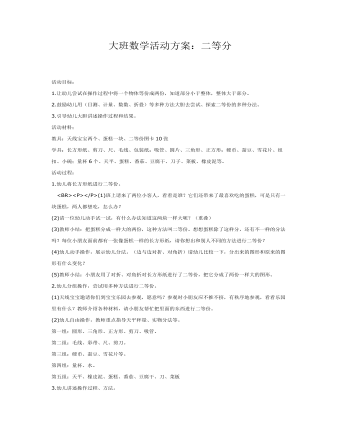
大班数学活动方案:二等分课件教案
2.鼓励幼儿用(目测、计量、数数、折叠)等多种方法大胆去尝试、探索二等份的多种分法。3.引导幼儿大胆讲述操作过程和结果。活动材料;教具:天线宝宝两个、蛋糕一块、二等份图卡10张学具:长方形纸、剪刀、尺、毛线、包装纸;吸管、圆片、三角形、正方形;硬币、蚕豆、雪花片、纽扣、小碗;量杯6个、天平、蛋糕、番茄、豆腐干、刀子、菜板、橡皮泥等。活动过程:1.幼儿将长方形纸进行二等份。 (1)班上请来了两位小客人,看看是谁?它们还带来了最喜欢吃的蛋糕,可是只有一块蛋糕,两人都想吃,怎么办?(2)请一位幼儿动手试一试,有什么办法知道这两块一样大呢?(重叠)(3)教师小结:把蛋糕分成一样大的两份,这种方法叫二等份。想想蛋糕除了这样分,还有不一样的分法吗?每位小朋友面前都有一张像蛋糕一样的长方形纸,请你想出和别人不同的方法进行二等份?(4)幼儿动手操作,展示幼儿分法。(边与边对折、对角折)请幼儿比较一下,分出来的图形和原来的图形有什么变化?(5)教师小结:小朋友用了对折、对角折对长方形纸进行了二等份,把它分成了两份一样大的图形。
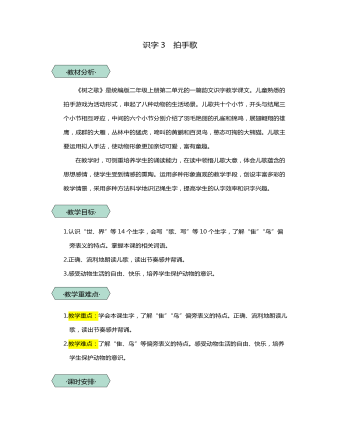
统编版二年级语文上识字3拍手歌教案
《树之歌》是统编版二年级上册第二单元的一篇韵文识字教学课文。儿童熟悉的拍手游戏为活动形式,串起了八种动物的生活场景。儿歌共十个小节,开头与结尾三个小节相互呼应,中间的六个小节分别介绍了羽毛艳丽的孔雀和锦鸡,展翅翱翔的雄鹰,成群的大雁,丛林中的猛虎,啼叫的黄鹂和百灵鸟,憨态可掬的大熊猫。儿歌主要运用拟人手法,使动物形象更加亲切可爱,富有童趣。在教学时,可侧重培养学生的诵读能力,在读中领悟儿歌大意,体会儿歌蕴含的思想感情,使学生受到情感的熏陶。运用多种形象直观的教学手段,创设丰富多彩的教学情景,采用多种方法科学地识记绳生字,提高学生的认字效率和识字兴趣。 1.认识“世、界”等14个生字,会写“歌、写”等10个生字,了解“隹”“鸟”偏旁表义的特点。掌握本课的相关词语。2.正确、流利地朗读儿歌,读出节奏感并背诵。3.感受动物生活的自由、快乐,培养学生保护动物的意识。 1.教学重点:学会本课生字,了解“隹”“鸟”偏旁表义的特点。正确、流利地朗读儿歌,读出节奏感并背诵。2.教学难点:了解“隹、鸟”等偏旁表义的特点。感受动物生活的自由、快乐,培养学生保护动物的意识。 2课时
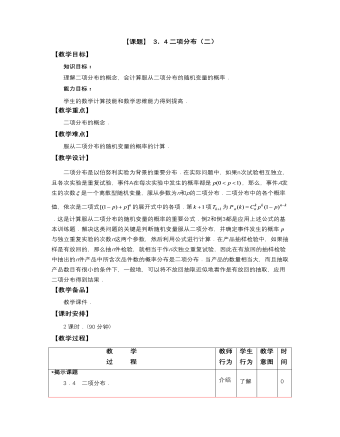
【高教版】中职数学拓展模块:3.4《二项分布》教案设计
教 学 过 程教师 行为学生 行为教学 意图时间 *揭示课题 3.4 二项分布. *创设情境 兴趣导入 我们来看一个问题:从100件产品中有3件不合格品,每次抽取一件有放回地抽取三次,抽到不合格品的次数用表示,求离散型随机变量的概率分布. 由于是有放回的抽取,所以这种抽取是是独立的重复试验.随机变量的所有取值为:0,1,2,3.显然,对于一次抽取,抽到不合格品的概率为0.03,抽到合格品的概率为1-0.03.于是的概率(仅求到组合数形式)分别为: , , , . 所以,随机变量的概率分布为 0123P 介绍 播放 课件 质疑 了解 观看 课件 思考 引导 启发学生得出结果 0 10*动脑思考 探索新知 一般地,如果在一次试验中某事件A发生的概率是P,随机变量为n次独立试验中事件A发生的次数,那么随机变量的概率分布为: 01…k…nP…… 其中. 我们将这种形式的随机变量的概率分布叫做二项分布.称随机变量服从参数为n和P的二项分布,记为~B(n,P). 二项分布中的各个概率值,依次是二项式的展开式中的各项.第k+1项为. 二项分布是以伯努利概型为背景的重要分布,有着广泛的应用. 在实际问题中,如果n次试验相互独立,且各次实验是重复试验,事件A在每次实验中发生的概率都是p(0<p<1),则事件A发生的次数是一个离散型随机变量,服从参数为n和P的二项分布. 总结 归纳 分析 关键 词语 思考 理解 记忆 引导学生发现解决问题方法 20
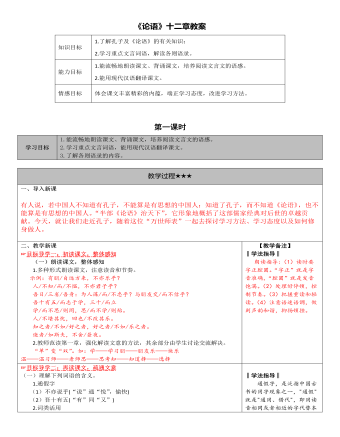
部编版语文七年级上册《论语》十二章教案
2.在新知与旧知、知识与实践的关系上,在学与思、学与问的关系上,孔子是怎么看的?新知与旧知的关系上,孔子认为“温故”可以“知新”。也只有“温故”“知新”的人才能当老师。这里,孔子强调的是“新知”,是那种开拓、创新的精神。在知识与实践的关系上,孔子认为“学而时习之”。学了知识要按时去实习,把所学的东西运用到行动上,在实践中提高对知识的掌握程度。在学与思的关系上,孔子认为学习与思考必须结合,二者缺一不可。只读书而不通过自己的头脑加以思考,就会感到迷惑;只是一味空想而不读书,就会精神疲惫。在学与问的关系上,孔子主张既学又问,不仅问知识才能比自己高的人,即使是知识才能比自己低的人,只要他们在某一方面有一技之长、一得之见,就应该虚心向他们求教,不以为羞耻。
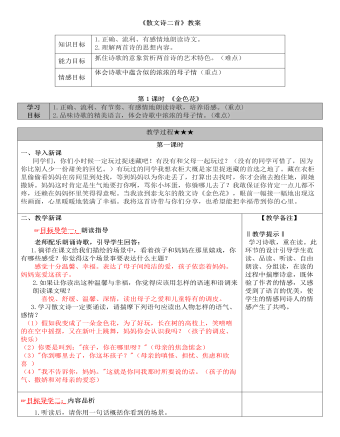
部编版语文七年级上册《散文诗二首》教案
?目标导学三:拓展延伸 1.请你模仿例句仿写。例句:母亲啊!你是荷叶,我是红莲,心中的雨点来了,除了你,谁是我在无遮拦天空下的荫蔽? 仿写: 示例一 :母亲啊,你是流水,我是鱼儿,当干旱来临时,除了你,谁还能为我提供一个安定的家?示例二:母亲啊,你是避风港,我是小船,狂风暴雨来临时,除了你,谁是我在无遮拦大海中的依靠? 示例三:母亲啊,你是鸟巢,我是小鸟,心中的寒冷来了,除了你,谁是我在冷风中的温暖? 2. 人说:天下的母亲有着不一样的面容,但唯有一样——母爱,是完全一样的。同学们,我们享受母爱十余载,那么你们的母亲是如何保护、关爱你们的呢?
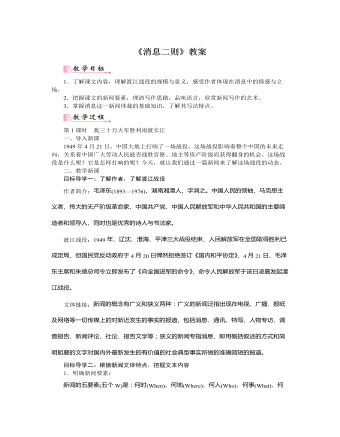
部编版语文八年级上册《消息二则》教案
结果:突破长江防线,占领南岸广大地区。目标导学二:细读课文,深层探究本篇报道的主体是写三路大军渡江战斗的经过,为何从中路写起?何处详写?何处略写?为什么这样安排?明确:中路于二十日首先渡江,所以先写。二十一日夜即已渡完,只用一句话就交代清楚了。至于其受阻情况,因与西路一样,敌人“纷纷溃退,毫无斗志”,所以此路略写。次写西路,详写。最后写东路,详写。由于这里敌人的防线比较巩固,加之此处敌军抵抗较为顽强,更重要的是这一地区战略意义重大,直接关系到能否包围敌军、解放南京,因此报道写得十分具体。尤其是最后两句详写了我军的战果,是为了说明水路长江和陆路镇江、无锡段铁路线已经全部被我军切断,敌人毫无退路,敌我双方态势已十分明显。
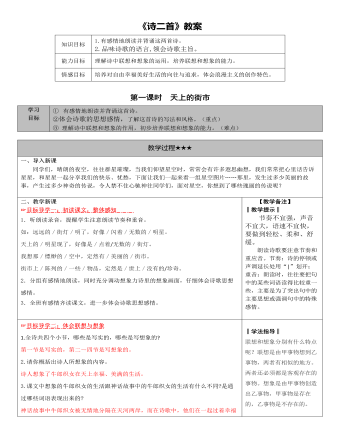
部编版语文七年级上册《诗二首》教案
目标导学三:品味语言,拓展延伸 1.第一节的运用了什么修辞?有何好处? 运用了比喻的修辞。前两句的比喻,本体是“街灯”,喻体是“明星”;后两句比喻的本体是“明星”喻体是“街灯”。这是一种回环往复的比喻,读起来特别的美,而内容上又从地上联想到了天上。这两个比喻构成了从地上写到天上的桥梁或天梯,写得天衣无缝,不露痕迹,非常自然。 2.后面三节,用了四个“定然”,一个“定”,有什么作用? 诗中的“定然”“定”表现的明明是想象的内容,却用断定的语气加以肯定,表明作者坚信,这样的理想世界是存在的,他对美好的未来充满信心,使读者受到感染和鼓舞。 3.“不信,请看那朵流星”中“朵”可不可以换成“颗”?“朵”用来作流星的量词,而不用“颗”,写出了流星的美,就像花儿一样。与牛郎织女的美好生活相映成趣。
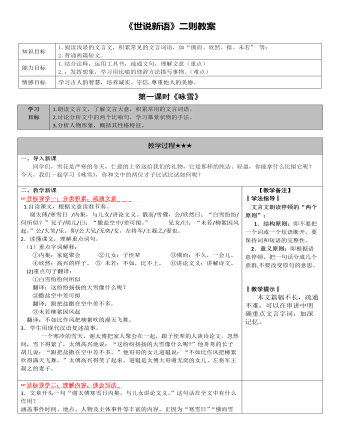
部编版语文七年级上册《世说新语》二则教案
?目标导学二:理解内容,体会写法 1.文章开头一句“谢太傅寒雪日内集,与儿女讲论文义。”这句话在全文中有什么作用? 涵盖事件时间、地点、人物及主体事件等丰富的内容。正因为“寒雪日”“俄而雪骤”,才能引出“咏雪。2.“寒雪”“内集”“欣然”“大笑”’等词语营造了一种怎样的家庭氛围?营造了一种融洽、欢快、轻松的家庭氛围。3.“咏雪”的过程中,文章特别记载了两个人的咏,即用“撒盐空中”和“柳絮因风起”来比拟“大雪纷纷”,你对其中哪一个更欣赏?为什么?“柳絮因风起”更好,因为柳絮比盐更像雪。给人以春天即将到来的感觉,意蕴强,有美感,这是“撒盐空中”所缺乏的。“撒盐空中”比喻了雪的颜色。 4.文章结尾交待了谢道韫的身份,有什么用意?谢太傅对两人的答案未做评定,只是“大笑乐”而已,十分耐人寻味。作者也没有表态,却在最后补充了道韫的身份,这是一个有力的暗示,表明他赞赏道韫的才气。

人教版高中语文必修3《马嵬(其二)》教案2篇
结合历史自古以来,江山美人历来都是引无数英雄豪杰竞折腰的,如果说英雄选择了美人却丢了江山,把所有罪名都归结于“女人是祸水”。但是,纣王无道,和有了妲己有必然的联系吗?有人说妲己坏透了,坏透了的妲己如果不是取得纣王的信任是坏不起来的,纣王听信了妲己的谗言,听与不听决定权在纣王,而不在妲己。强势永远在纣王一边。再来看看西施和杨贵妃:西施是作为越国贡献给吴国的供品来到吴王夫差的身边的,杨贵妃更是先是李隆基的儿媳妇被看中而得宠的。所以,西施和杨贵妃这两个可怜的女人根本没有自己的独立选择,没有独立的爱情,如果没有西施,就会有南施,或北施;如果没有杨贵妃,就会有李贵妃,王贵妃,总之什么施,什么妃是不能少的,因为那是吴王和李隆基的需要。
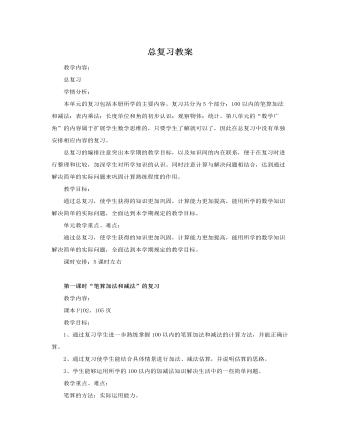
人教版新课标小学数学二年级上册总复习教案
教学内容:课本P104、108页。教学目标:1、通过复习使学生加深了解统计的意义。2、巩固学生对条形统计图的认知,明确用1格表示2个单位的表现形式,能根据统计图提出问题。3、在学习过程中培养学生的实践能力与合作意识。教学重点、难点:1、在复习中进一步了解统计的意义,加深对条形统计图的认识。2、能根据条形统计图的条件提出数学问题。教学过程:一、复习统计1、观察讨论(1)、教师出示条形统计图:这张图叫什么名字?它有什么作用?仔细观察统计图你有哪些发现?(2)、学生观察讨论,思考,依据自己的体验回答。仔细观察统计图,在小组内交流自己的发现。(3)、组织全班汇报交流,梳理统计图信息。2、回答问题根据条形统计图上的信息,你能回答下列问题吗?1)、最受二年级同学欢迎的饮料是什么?你是怎么看出来的?2)、喜欢哪两种饮料的人数同样多?你是怎么知道的?

新人教版高中英语必修2Unit 1 Cultural Heritage-Discovering Useful Structure教案二
This theme of the part is “ Describe people or things in greater detail”. Students have learned the grammar(restrictive relative clauses) in Book 1, and further review and consolidate its structure “prep+relative pronouns(which/whom)” and the relative adverbs(when, where and why), besides students should understand its form, meaning and functions. In this section, students should be able to express the grammar correctly in daily communication and in the writing. 1. Review the basic usages of relative pronouns and adverbs of attributive clauses . 2. Learn to use some special cases about restrictive relative clauses.3. Learn to write sentences with restrictive relative clauses flexibly according to the context.1. Review the basic usages of relative pronouns and adverbs of attributive clauses .2. Learn to use some special cases about restrictive relative clauses.3. Learn tow rite sentences with restrictive relative clauses flexibly according to the context.Step 1. Observe the following sentences, and mark the relative pronouns and the adverbs. 1. After listening to the scientists who had studied the problems, and citizens who lived near the dam, the government turned to the United Nations for help.2. Temples and other cultural sites were taken down piece by piece, and then moved and put back together again in a place where they were safe from the water.Step 2 PracticePlease complete these sentences with relative pronouns and relative adverbs and answer the following questions.Questions: 1. What is the head noun ?2. What relative words should be used ?3. What elements do they act in these sentences ?

新人教版高中英语必修2Unit 2 Wildlife Protection-Reading for Writing教案二
This lesson aims at making a poster about protecting wildlife after reading some posters. During reading students are guided to understand the content and try to summarize the posters with one sentence. Then students are guided to try to make a poster about protecting wildlife.1. Read the two posters and try to understand the summary sentences.2. Look at the two posters and try to understand what emotions they express.3. Try to summarize the features of posters4. Try to make a poster about wildlife.1. Look at the two posters and try to understand what emotions they express.2. Try to summarize the features of posters3. Try to make a poster about wildlife.Step 1 Lead inLook at the the posters on the textbook and ask:Which emotions do the posters communicate ?Step 2 Read the poster and answer the questions.1. What do you think of the animals in the poster on the left ?I think it is frightening and ugly.2. Why do we should protect the ugly animals ?All species--the good, the bad, and the ugly-- should be treated equally.The world needs all kinds--without variety, our planet cannot survive.3. Why are billions of trees being cut down every year ?To make paper for humans.4. What result will be lead to after the trees are cut down ?A lost of animal homes are being destroyed./The habitat of wildlife is being destroyed.Step 3 Find the feature of posters1. What does each poster use to stir up emotions ?On the left, it makes us a little frightened and it looks a little ugly, but it can activate our curiosity--What is it? And What is wrong with it?On the right, it makes us feel a little sad and want to protect them.
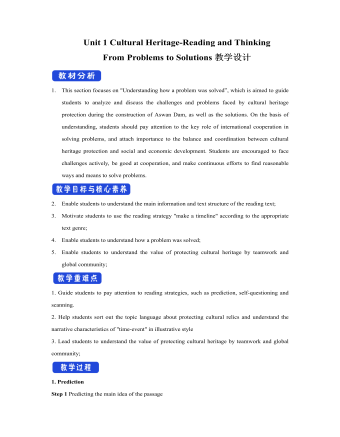
新人教版高中英语必修2Unit 1 Cultural Heritage-Reading and Thinking教案二
1. This section focuses on "Understanding how a problem was solved”, which is aimed to guide students to analyze and discuss the challenges and problems faced by cultural heritage protection during the construction of Aswan Dam, as well as the solutions. On the basis of understanding, students should pay attention to the key role of international cooperation in solving problems, and attach importance to the balance and coordination between cultural heritage protection and social and economic development. Students are encouraged to face challenges actively, be good at cooperation, and make continuous efforts to find reasonable ways and means to solve problems.2. Enable students to understand the main information and text structure of the reading text;3. Motivate students to use the reading strategy "make a timeline" according to the appropriate text genre;4. Enable students to understand how a problem was solved;5. Enable students to understand the value of protecting cultural heritage by teamwork and global community;1. Guide students to pay attention to reading strategies, such as prediction, self-questioning and scanning.2. Help students sort out the topic language about protecting cultural relics and understand the narrative characteristics of "time-event" in illustrative style3. Lead students to understand the value of protecting cultural heritage by teamwork and global community;

新人教版高中英语必修2Unit 2 Wildlife Protection-Discovering Useful Structure教案二
2.表示现阶段正在进行的被动动作(该动作在说话的瞬间未必正在进行)。Many interesting experiments are being carried out these days.(说话时,并不一定正在进行)3.表示一种经常性的被动行为,常和always,constantly 等表示频度的副词连用,这种用法常常带有赞扬或厌恶的感情色彩。He is always being praised by the leader.4.表示按计划或安排主语将要承受谓语动词所表示的动作(仅限于少数及物动词)。A party is being held tonight.Step 4 Special cases1.像take care of, look after, talk about, think of等动词与介词构成的短语用于现在进行时的被动语态时, 其中的介词不可省略。The ways to stop illegally hunting are being talked about. 2.可与部分情态动词连用,表示对正在发生的事情的推测。She may be being punished by her mother.3.有时可表示按计划或安排将要进行的一个被动动作。A celebration is being held this weekend for his success.4.某些表示“状态、心理活动、存在”等的动词,如have,want,need,love,一般不用现在进行时的被动语态,而常用一般现在时的被动语态。With the population increasing,more land is needed.5.“be+under/in+n.”可表示现在进行时的被动意义。My computer is under repair.=My computer is being repaired.

新人教版高中英语必修2Unit 2 Wildlife Protection-Reading and Thinking教案二
The theme of this unit is human and nature, focusing on the theme of wildlife protection. Nature is a complex ecosystem, in which there are delicate balance between animals and plants. Because of the role of the food chain, the extinction of one species will produce influence, causing a series of chain reaction. Large scale extinction of species will have a serious and even irreversible impact on the ecosystem, resulting in immeasurable losses. Therefore, it is of great significance to protect wild species. To protect wild species is to protect human beings themselves. The motto of this unit is "when the buying stops, the killing can too,” which is a public service advertising slogan to protect wildlife. It tells people that every rhinoceros horn, every fur, every bowl of shark fin soup, every Ivory product, and every tiger bone product, etc. consumed by human beings, are innocent wild animals slaughtered behind them. The mission of wild aid is to ban illegal trade in endangered wildlife and mitigate climate change. It aims to educate the public to reduce the consumption demand for endangered wildlife products through public publicity and improve the awareness of environmental protection.1. Improve the awareness of wildlife protection by acquiring the knowledge of wildlife protection.2. Focus on environmental protection and protection of all lives.3. Analysis of the living environment of wild animals with appropriate thinking mode.4. Skillfully use the vocabulary and grammar knowledge of this unit to cultivate self-study ability according to the unit content5. Develop cooperative learning ability through discussion and other ways1. Enable the Ss to talk about the current situation of wild animals.2. Guide the Ss to summarize the main idea of each paragraph as well as the main idea of the text.

新人教版高中英语必修2Unit 3 The Internet-Discovering Useful Structure教案二
This teaching period mainly deals with grammar “The Present Perfect Passive Voice.” To begin with, teachers should lead students to revise what they have learned about the Present Perfect Passive Voice. And then, teachers move on to stress more special cases concerning this grammar。This period carries considerable significance to the cultivation of students’ writing competence and lays a solid foundation for the basic appreciation of language beauty. The teacher is expected to enable students to master this period thoroughly and consolidate the knowledge by doing some exercises. 1. Guide students to review the basic usages of the Present Perfect Passive Voice2. Lead students to learn to use some special cases concerning the Present Perfect Passive Voice flexibly.2. Enable students to use the basic phrases structures flexibly.3. Strengthen students’ great interest in grammar learning.1. Help students to appreciate the function of the Present Perfect Passive Voice in a sentence2. Instruct students to write essays using the proper the Present Perfect Passive Voice.观察下列句子特点,总结共同点。1.(教材P28)Much has been written about the wonders of the World Wide Web.2.(教材P28)But the Internet has done much more for people than simply make life more convenient.3.(教材P28)Many people have been helped by the club.4.(教材P28)She no longer feels lonely, and her company has become quite successful.5.(教材P32)Today I thought I’d blog about a question that has been asked many times—how do you stay safe online and avoid bad experiences on the Internet?

新人教版高中英语必修2Unit 3 The Internet-Listening &Speaking&Talking教案二
From the pictures in the text and the title--- choose the best app, we can know that this part is about how to save money by using apps.Step 2 While-listening1. Laura and Xiao Bo are talking about apps. Listen to their conversation and find out what apps they want.Xiao Bo is looking for a(n) exercise app to help him get in shape.Laura would like an app for getting rich and another that will make her grades better.2. Listen again. Are the sentences true T or false F?1). Both of Xiao Bo's apps keep track of the steps he takes._____2). Xiao Bo's second app can help him make a fitness plan._____3). Laura needs an app that will help her get discounts.______4). Laura needs an app that will add money to her bank account._______F T F T3. Listen once more and tick the sentence you hear. Underline the words used to express predictions, guesses, and beliefs.Predictions, Guesses, and Beliefs________It might help me walk more.________My guess is that it wouldn't work.________I imagine this app would help me get fit faster________I suppose that would be good.________I guess you could save a little with this app.________I suppose there would be some problems, too.________I believe this app could help me get thinner.

新人教版高中英语必修2Unit 3 The Internet-Reading and Thinking教案二
Q5:What's Jan's next goal?Her next goal is to start a charity website to raise money for children in poor countries.Q6:What can we learn from her experiences?We learn that when we go through tough times, we can find help and support from other people online. We learn that we can feel less lonelyStep 5: While reading---rethinkingQ1: What is Jan’s attitude to the Internet ?Thankful/Grateful, because it has changed her and her life.Q2: What writing skills is used in the article ?Examples(Jan’s example, the 59-year-old man’s and the 61-year-old woman’s example)Q3: Can you get the main idea of the article ?The Internet has changed Jan’s life/Jan’s life has been changed by the Internet.Step 6 Post reading---Retell the storyMuch has been written about the wonders of the World Wide Web. There are countless articles (1)telling(tell) us how the Internet has made our lives more convenient. But the Internet has done a lot (2)more(much) for people than simply make life more convenient. People’s lives (3) have been changed(change) by online communities and social networks so far. Take Jan for example, who developed a serious illness that made her (4)stuck(stick) at home with only her computer to keep (5)her(she) company. She joined an online group (6)where she could share problems, support and advice with others. She considered the ability to remove the distance between people as one of the greatest (7)benefits(benefit). She was so inspired (8)that she started an IT club in which many people have been helped. She has started to learn more about how to use the Internet to make society better. Her next goal is to start a charity website to raise money (9)for children in poor countries. Jan’s life has been (10)greatly(great) improved by the Internet.

新人教版高中英语必修2Unit 3 The Internet-Reading for Writing教案二
8. However, the more polite you are, the less likely it is you will be attacked. 然而, 你越有礼貌, 你被攻击的可能性就越小。 Step 8 Writing---the articleHow to stay safe in the online chat roomToday I thought I’d blog about a question that has been asked many times--- how do you stay safe online and avoid bad experiences in the online chat room ? I’m not an expert, but many years as a blogger have taught me a thing or two.First of all, there’s the golden rule of the Internet: keep out of what makes you uneasy. Don’t post comments or click on anything. Second, protect your privacy. Don’t give out too much private information like your address, phone numbers, the ID numbers, etc. Third, be polite. If you are polite to others on the Internet, you won’t be attacked in normal situation. Finally, don’t believe in others easily and never meet someone you met online alone. It is very dangerous.Have you had any bad experiences online, or do you have some good advice for staying safe? Post your comments below!Step 9 Pair workExchange drafts with a partner. Use this checklist to help your partner revise his/her draft.1. Does the writer tell the reader what he/she know about the topic ?2. Are the tips and suggestions well organised ?3. Has the writer defined the new words ?4. Does the author include examples, comparison, or explanations ?5. Does the writer end by asking readers to leave comments and/or suggestions ?6. Can you find any grammar or spelling mistakes.Step 6 HomeworkPut up your revised draft in the classroom or read it to your class.

新人教版高中英语必修2Unit 4 History and Traditions-Discovering Useful Structure教案二
This teaching period mainly deals with grammar: The past participle is used as attributive and objective complement.1. Guide students to review the basic usages of the past participle used as attributive and objective complement.2. Lead students to learn to use some special cases concerning the past participle used as attributive and objective complement flexibly.3. Strengthen students’ great interest in grammar learning.1. Help students to appreciate the function of the past participle used as attributive and objective complement.2. Instruct students to write essays using the past participle used as attributive and objective complement.Step1:温故而知新。Analyze the underlined phrases and then sum up the common usages of the past participles.1.(教材P41)They had castles built(build) all around England, and made changes to the legal system.2.(教材P42)They use the same flag, known(know) as the Union Jack,...3.(教材P42)Judy and I had our car parked(park) in an underground car park near Trafalgar Square, where we could get our car battery charged(charge).Common points: f the past participle used as attributive and objective complement.Step 2:过去分词作定语时的意义1.及物动词的过去分词作定语,在语态上表示被动;在时间上,常表示动作已经发生或完成,有时也不表示时间性。Our teacher watched us doing the experiment and gave us a satisfied smile at last.我们的老师看着我们做实验,最后给了我们一个满意的微笑。The plan put forward at the meeting will be carried out soon.会上提出的计划将很快被执行。2.不及物动词的过去分词作定语,它不表示被动意义,只强调动作完成。Many little kids like gathering fallen leaves in the yard.